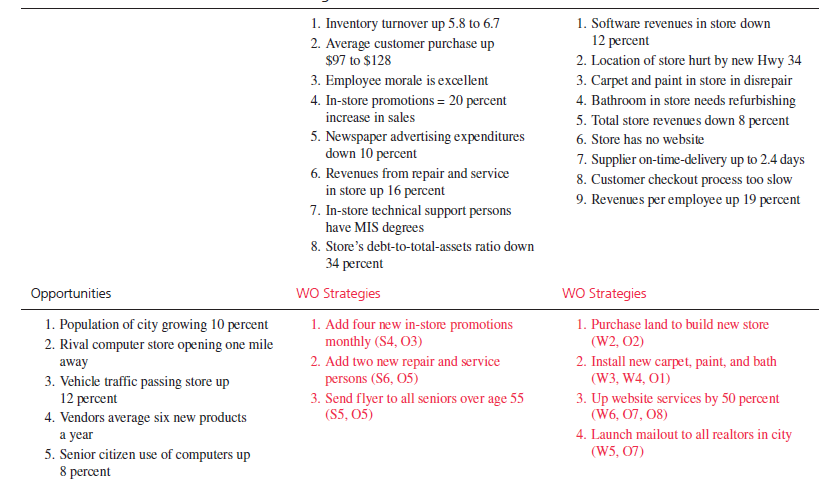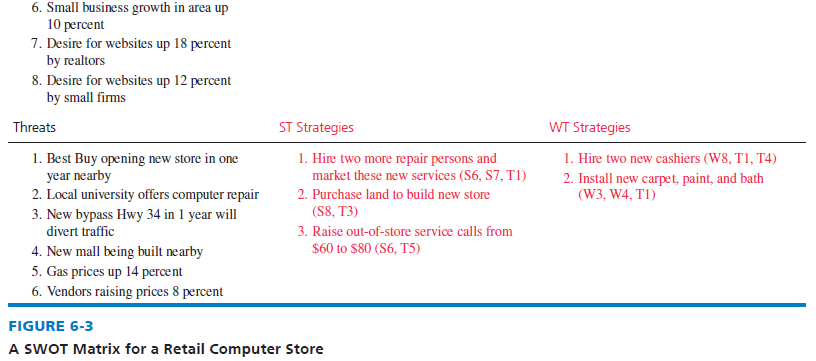The Strengths-Weaknesses-Opportunities-Threats (SWOT) Matrix is an important matching tool that helps managers develop four types of strategies: SO (strengths-opportunities) strategies, WO (weaknesses-opportunities) strategies, ST (strengths-threats) strategies, and WT (weaknesses- threats) strategies.3 Matching key external and internal factors is the most difficult part of developing a SWOT Matrix, as it requires good judgment—and there is no one best set of matches. Note in Table 6-1 that the first, second, third, and fourth strategies are SO, WO, ST, and WT strategies, respectively.
SO strategies use a firm’s internal strengths to take advantage of external opportunities. All managers would like their organization to be in a position in which internal strengths can be used to take advantage of external trends and events. Organizations generally will pursue WO, ST, or WT strategies to get into a situation in which they can apply SO strategies. When a firm has major weaknesses, it will strive to overcome them and make them strengths. When an organization faces major threats, it will seek to avoid them to concentrate on opportunities.

WO strategies aim at improving internal weaknesses by taking advantage of external opportunities. Sometimes key external opportunities exist, but a firm has internal weaknesses that prevent it from exploiting those opportunities. For example, there may be a high demand for electronic devices to control the amount and timing of fuel injection in automobile engines (opportunity), but a certain auto parts manufacturer may lack the technology required for producing these devices (weakness). One possible WO strategy would be to acquire this technology by forming a joint venture with a firm having competency in this area. An alternative WO strategy would be to hire and train people with the required technical capabilities.
ST strategies use a firm’s strengths to avoid or reduce the impact of external threats. This does not mean that a strong organization should always meet threats in the external environment head-on. An example ST strategy occurred when Texas Instruments used an excellent legal department (a strength) to collect nearly $700 million in damages and royalties from nine Japanese and Korean firms that infringed on patents for semiconductor memory chips (threat). Rival firms that copy ideas, innovations, and patented products are a threat in many industries.
WT strategies are defensive tactics directed at reducing internal weakness and avoiding external threats. An organization faced with numerous external threats and internal weaknesses may indeed be in a precarious position. In fact, such a firm may have to fight for its survival, merge, retrench, declare bankruptcy, or choose liquidation.
A schematic representation of the SWOT Matrix is provided in Figure 6-3. Note that a SWOT Matrix is composed of nine cells. As shown, there are four key factor cells, four strategy cells, and one cell that is always left blank (the upper-left cell). The four strategy cells, labeled SO, WO, ST, and WT, are developed after completing four key factor cells, labeled S, W, O, and T. The process of constructing a SWOT Matrix can be summarized in eight steps, as follows:
- List the firm’s key external opportunities.
- List the firm’s key external threats.
- List the firm’s key internal strengths.
- List the firm’s key internal weaknesses.
- Match internal strengths with external opportunities, and record the resultant SO strategies in the appropriate cell.
- Match internal weaknesses with external opportunities, and record the resultant WO strategies.
- Match internal strengths with external threats, and record the resultant ST strategies.
- Match internal weaknesses with external threats, and record the resultant WT strategies.
Some important aspects of a SWOT Matrix are evidenced in Figure 6-3. For example, note that both the internal and external factors and the SO, ST, WO, and WT strategies are stated in quantitative terms. This is important! For example, regarding the second SO number 2 and ST number 1 strategies, if the analyst just said, “Add new repair and service persons,” the reader might think that 20 new repair and service persons are needed. Actually only 2 are needed. So, with strategies, as with the underlying key external and internal factors, be specific, actionable, and divisional to the extent possible.
It is also important to include the “S1, O2” type notation after each strategy in a SWOT Matrix. This notation reveals the rationale for each alternative strategy. Strategies do not appear out of the blue. Note in Figure 6-3 how this notation reveals the internal and external factors that were matched to formulate desirable strategies. For example, note that this retail computer store business may need to “purchase land to build new store” because a new Highway 34 will make its location less desirable. The notation (W2, O2) and (S8, T3) in Figure 6-3 exemplifies this matching process.
The purpose of SWOT analysis and each Stage 2 matching tool is to generate feasible alternative strategies, not to select or determine which strategies are best. Not all of the strategies developed in the SWOT Matrix will be selected for implementation. No firm has sufficient capital or resources to implement every strategy formulated.
The strategy-formulation guidelines provided in Chapter 5 can enhance the process of matching key external and internal factors. For example, when an organization has both the capital and human resources needed to distribute its own products (internal strength) and distributors are unreliable, costly, or incapable of meeting the firm’s needs (external threat), forward integration can be an attractive ST strategy. When a firm has excess production capacity (internal weakness) and its basic industry is experiencing declining annual sales and profits (external threat), related diversification can be an effective WT strategy.


Although the SWOT Matrix is widely used in strategic planning, the analysis does have some limitations.4 First, SWOT does not show how to achieve a competitive advantage, so it must not be an end in itself. The matrix should be the starting point for a discussion on how proposed strategies could be implemented as well as cost/benefit considerations that ultimately could lead to competitive advantage. Second, SWOT is a static assessment (or snapshot) in time. A SWOT Matrix can be like studying a single frame of a motion picture where you see the lead characters and the setting but have no clue as to the plot. As circumstances, capabilities, threats, and strategies change, the dynamics of a competitive environment may not be revealed in a single matrix. Third, SWOT analysis may lead the firm to overemphasize a single internal or external factor in formulating strategies. There are interrelationships among the key internal and external factors that SWOT does not reveal that may be important in devising strategies. Fourth, there are no weights, ratings, or numbers in a SWOT analysis. Finally, the relative attractiveness of alternative strategies is not provided.
Source: David Fred, David Forest (2016), Strategic Management: A Competitive Advantage Approach, Concepts and Cases, Pearson (16th Edition).

Just a smiling visitor here to share the love (:, btw great design and style.